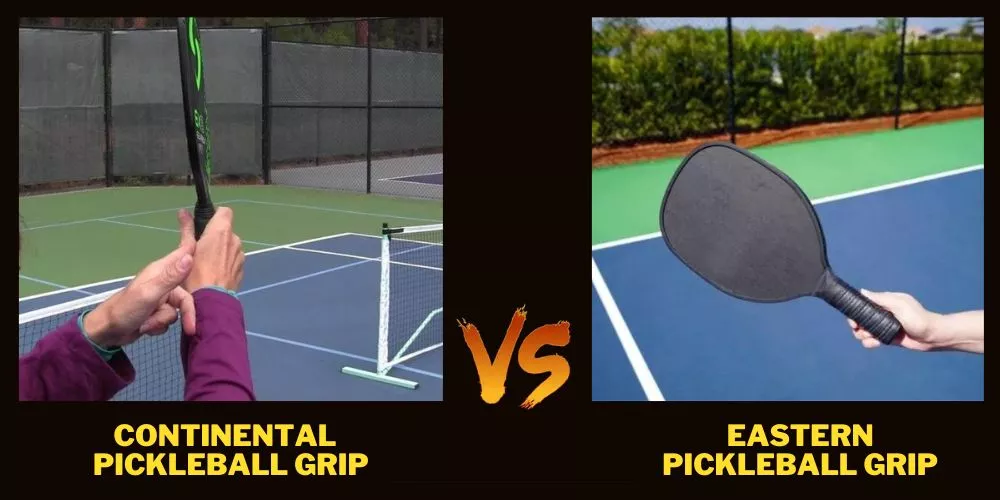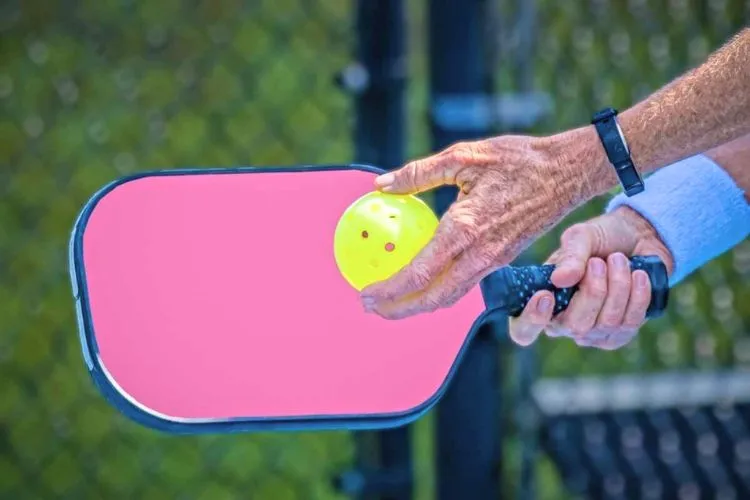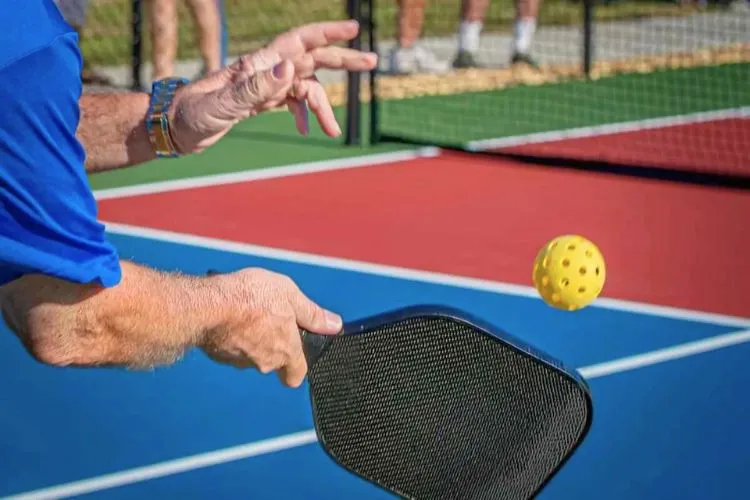In the sport of pickleball, the grip you use can significantly impact your performance and overall game.
Two common grip techniques used by players are the continental grip and the eastern grip.
Today we will do the breakdown of the continental vs eastern pickleball grip comparison to find the winner.
The continental grip involves positioning your hand so that the base knuckle of your index finger is on the bevel of the paddle, while the eastern grip involves placing the base knuckle of your index finger slightly to the right of the bevel.

These grip variations offer different advantages and challenges, and understanding their nuances can help players optimize their gameplay.
In this article, we explore the continental and eastern pickleball grips, outlining their techniques, benefits, and considerations for players.
Continental Grip
The continental grip is widely regarded as the standard grip in pickleball. It is similar to the grip used in tennis and is known for its versatility, allowing players to execute various shots with control and accuracy.
To adopt the continental grip, follow these steps:
- Place your non-dominant hand on top of the paddle handle with a relaxed grip.
- Position the base knuckle of your dominant hand’s index finger on the bevel of the paddle, pointing towards the desired direction of your shot.
- Wrap your fingers around the handle, ensuring a secure and comfortable grip.

Advantages of the Continental Grip
- Wrist Flexibility: The continental grip facilitates wrist flexibility, allowing players to generate spin and control the direction of their shots. It offers excellent maneuverability, making it suitable for quick volleys, dinks, and finesse shots.
- Quick Adjustment: With the continental grip, players can easily adjust their paddle face angle to execute different shots. This adaptability is particularly useful to respond to fast-paced rallies and unexpected shots from opponents.
- Slice and Spin: The continental grip provides optimal control over ball spin and slice shots. By adjusting the paddle face angle and using wrist action, players can generate topspin, backspin, and side spin on their shots, adding complexity and deception to their game.
Considerations for the Continental Grip
- Power Generation: While the continental grip is effective for controlling shots, it may be less powerful compared to other grips, limiting the potential for strong drives and smashes. Players who rely on power shots may need to adapt their technique or consider alternative grips.
- Backhand Shots: Players with a continental grip may find it challenging to execute strong backhand shots due to the wrist position. It may require additional practice to develop the necessary wrist strength and flexibility for backhand strokes.
Eastern Grip
The eastern grip is an alternative grip choice in pickleball. It differs from the continental grip in hand positioning, potentially influencing shot execution and play style. To adopt the eastern grip, follow these steps:
- Place your non-dominant hand on top of the paddle handle with a relaxed grip.
- Position the base knuckle of your dominant hand’s index finger just slightly to the right of the bevel of the paddle.
- Wrap your fingers around the handle, maintaining a firm and comfortable grip.

Advantages of the Eastern Grip
- Power and Drive Shots: The eastern grip allows players to generate more power and drive in their shots compared to the continental grip. It can be especially beneficial for players who rely on strong baseline shots and aggressive smashes.
- Forehand Dominance: The positioning of the eastern grip supports strong forehand strokes, enabling players to hit powerful shots with greater ease and control. This grip may suit players who prefer forehand dominance in their playing style.
- Two-handed Backhand: The eastern grip can facilitate a two-handed backhand technique, allowing players to enhance their control and power on backhand shots. This grip is particularly advantageous for players who prefer a two-handed approach or who have a stronger non-dominant hand.
Considerations for the Eastern Grip
- Shot Control: While the eastern grip offers power and drive, it may require additional skill and finesse to control shots accurately. Players need to focus on developing the necessary touch and subtlety to maintain control during rallies and at the net.
- Reduced Wrist Flexibility: Compared to the continental grip, the eastern grip may limit wrist flexibility and the ability to generate intricate spin variations. Players who rely heavily on spin shots may find it challenging to achieve the same level of ball control with the eastern grip.
continental vs eastern pickleball grip: Choosing the Right Grip for You
Selecting the appropriate grip in pickleball depends on your skill level, playing style, and personal preferences. Here are some factors to consider when choosing between the continental and eastern grip:
- Skill Level: Beginner players may find it beneficial to start with the continental grip as it provides more control and versatility. As players advance and develop their skills, they may choose to experiment with the eastern grip to add power to their shots.
- Playing Style: Your preferred playing style can influence your grip choice. If you rely on finesse, touch, and quick adjustments, the continental grip may align better with your style. Players who prioritize power, aggression, and decisive shots may gravitate toward the eastern grip.
- Experimentation: It is essential to experiment with different grips during practice sessions to find the grip that feels most comfortable and natural to you. Consider seeking guidance from experienced players or a pickleball coach to refine your grip technique and optimize your game.
Frequently Asked Questions (FAQs)
What does a semi-western grip look like?
A semi-western grip is a tennis grip where the base knuckle of the index finger is placed slightly to the right of the bevel, typically at a 45-degree angle. This grip is commonly used for hitting topspin groundstrokes, especially on the forehand side. It allows players to brush up on the ball, generating more spin and controlling the trajectory of the shot.
Is Continental grip the same as Hammer grip?
No, the continental grip is not the same as the hammer grip. The continental grip is used in pickleball, whereas the hammer grip is a grip used in tennis. In pickleball, the continental grip involves placing the base knuckle of the index finger on the bevel of the paddle, while the hammer grip in tennis involves gripping the racket handle as if holding a hammer. These grips differ in hand positions and techniques specific to their respective sports.
Can I serve with an Eastern grip?
Yes, you can serve with an Eastern grip in pickleball. The Eastern grip can provide more power on your serve compared to the continental grip. To serve with an Eastern grip, position the base knuckle of your index finger just slightly to the right of the bevel on the paddle. This grip allows for a more pronounced swing and can generate more serve speed and power. However, practice and technique refinement are important to maintain accuracy and control when using this grip.
When should you use the continental grip?
The continental grip is commonly used in pickleball for its versatility and maneuverability. It is an ideal grip to use when you need to execute shots requiring control, spin, and quick adjustments. The continental grip is suitable for various shots such as volleys, dinks, and finesse shots. It allows players to generate spin and control the direction of their shots effectively. If you prioritize finesse, touch, and the ability to maneuver the ball effectively, the continental grip is worth considering.
Conclusion:
The continental grip and eastern grip are two widely used grip techniques in pickleball, each offering distinct advantages and considerations for players.
The continental grip emphasizes control, versatility, and spin, making it suitable for players who prioritize finesse and adaptability.
On the other hand, the eastern grip emphasizes power, drive shots, and forehand dominance, catering to players seeking aggressive play and strong baseline shots. Ultimately, the choice between these grips depends on your playing style, skill level, and personal preference.
Regular practice, experimentation, and seeking guidance can help you refine your grip technique and maximize your effectiveness on the pickleball court.

Pickleball’s more than a game to me—it’s a passion. I write, sharing its highs and lows, the thrills and the lessons. Some tales might draw you to the court, while others give a hint of the game’s magic. So, curious about my journey? Ready to dive deep into the world of pickleball with me? Let’s go.
